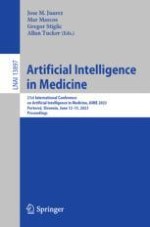2023 | Book
Artificial Intelligence in Medicine
21st International Conference on Artificial Intelligence in Medicine, AIME 2023, Portorož, Slovenia, June 12–15, 2023, Proceedings
Editors: Jose M. Juarez, Mar Marcos, Gregor Stiglic, Allan Tucker
Publisher: Springer Nature Switzerland
Book Series : Lecture Notes in Computer Science
